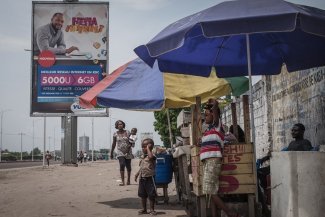The term “Washington Consensus” was coined more than two decades ago to describe a set of policy prescriptions that the International Monetary Fund (IMF) and World Bank promised would be bring economic prosperity to developing countries.
Under the tenure of World Bank President Jim Yong Kim, there is a new “consensus” developing in Washington. But this policy agenda looks remarkably similar to how it did twenty years ago. In fact, it involves revisiting and re-emphasising more of the same – albeit repackaged with the promise of more efficient implementation.
When the Washington Consensus was popularised in the late 1980s it described a series of policy prescriptions that by now follow a familiar recipe: the main ingredient was a healthy dollop of fiscal policy discipline combined with the redirection of subsidies, such as those on fuel or food, to spending on education, health and infrastructure.
All this was served up alongside a sizeable portion of lowered marginal tax rates, trade liberalisation, privatisation of state owned enterprises and public services, deregulation, and efforts to strengthen legal security for property rights.
These prescriptions have resurfaced in recently-approved Bank strategy documents and policy advice to governments. The Bank is to resume the funding of large infrastructure projects, something that it had scaled down but has now resumed to make good its promise to create jobs.
Lending procedures are to be sped up to get loans out the door. Ways to make the Bank’s policies that safeguard against environmental and other impacts on communities in projects more streamlined are being looked at.
In short, the Bank’s new emphasis is on making itself more efficient at implementing the Washington Consensus policy mix, rather than on undertaking any significant rethink.
The key question for the Bank is will this repackaged agenda simply reinforce an unwelcome status quo? A status quo in which gains for workers and the poor will be eroded – as they have been over the past twenty years – by what we are told are a series of inexorable forces?
These amorphous forces include technological change, the globalisation of international trade, the growth in the financial sector or financialisation, and declines in worker’s bargaining power.
Or maybe these are not in fact inexorable forces that have eroded gains, but instead are indicative that vested interests have been uncommonly successful in seizing the fruits of Washington Consensus-style policies?
A select few
The current recycling of the Washington Consensus is troubling because the Bank appears not to accept the evidence that this agenda has not delivered for the great majority of people.
At the same time, its policies have handsomely rewarded a select few.
Since 1980 there has been a startling change in the distribution of national income in most countries around the world – steep declines in worker’s share of national income has been particularly noticeable.
With respect to the very poor, the Bank estimates that 1.9 billion people lived in extreme poverty in 1990 (surviving on under US$1.25 a day). Yet two decades later, although poverty rates have declined, in 2010 there were still 1.2 billion people living in extreme poverty.
And in those places where poverty reduction has been the most dramatic, such as in China, it has come largely by selectively ignoring central aspects of Bank advice.
Worryingly, China’s poverty reduction has also been secured by growth that raises persistent questions about its sustainability, and at what are clearly unsustainable costs in terms of the environment, health and consumer protection, and repression intended to dampen organised demands for social justice.
Last month, the Bank made these recommendations for Africa, almost identical to the old Washington Consensus fiscal policy mix. Build human and physical capital through investment in health, education and infrastructure (transport, energy, water, communications), the Bank says.
A new tweak, for those countries rich in natural resources such as oil and gas, is to consider provision of cash transfers directly to the poor.
But for those poor countries without natural resource revenues, spending on social protection is to be kept to a minimum. Stick to this and it will drive jobs and growth, the Bank promises.
On the face of it, there is nothing wrong with spending on health, education, and infrastructure as the Bank suggests. In fact, trade unions have been among the keenest supporters of universal health coverage and free primary education, and welcome job-creating infrastructure.
But it is essential to look at the fine print to consider what this agenda is leaving out, as well as to scrutinize how the Bank proposes that these priorities be implemented.
What’s being left out?
A recent World Bank working paper giving policy advice to Pakistan’s government provides a good illustration.
It lays out the costs and benefits of differing policy choices over the next ten years. The paper examines the possibility of increased spending on infrastructure and what implications this might have for growth, employment, social protection and tax policy.
With respect to social protection, the paper concludes that “transfer programs can generate immediate welfare gains but are less effective over time unless they are designed to raise productivity, perhaps via improvements in health, nutrition, and education outcomes.”
This is intended to green light the Bank’s patchy, limited program of cash transfers, but to discourage spending on pensions, unemployment benefits and disability, which the Bank considers unproductive.
Also significant is the paper’s advice on tax policy.
Pakistan has among the lowest rates of tax collection in the world, equivalent to 9.7 per cent of GDP (the developing world average is around 18 per cent). Yet the paper’s assumptions about the impact of taxes on growth rates results in policy advice that discourages efforts at increased levels of progressive tax collection.
The paper warns that if domestic taxation were raised by a very modest 2.2 per cent of GDP over a ten year period, it would slow the growth rate and therefore the pace of poverty elimination.
It argues that by the end of the decade this would leave the poverty rate at 0.4 per cent higher if taxes had not been raised.
It is essential that estimates of tax collection be based on what is realistically feasible for authorities to collect.
But what is notable about the paper’s assertion is that it is based on a series of economic modeling assumptions.
The assumptions include the degree to which taxes might suppress private sector investment, and what might be the rates of return on government and private sector investment.
Many of these assumptions are derived from spotty empirical data and are inherently subjective. Yet their effect is to produce Bank policy advice to governments strongly biased toward low taxes even in such a low tax environment as Pakistan.
This is significant as it discourages governments from considering efforts to expand social protection to combat inequality. And it is surprising given that even publications such as The Economist, normally not a friend to redistribution, mull over fiscal policy responses to labor’s declining income share, which include providing a guaranteed minimum basic income.
This Washington Consensus fiscal policy mix is especially alarming when combined with the slew of other policies pushed by the Bank, almost all of which when implemented have reinforced inequality.
These include discouraging the adoption of minimum wages and encouraging labour market flexibility intended to eliminate worker protections.
It also includes vociferous and repeated calls by senior Bank staff for the privatisation of public services and the use of contract workers in education, which push down public sector workers’ earnings.
Shared prosperity?
Equally disappointing has been the manner in which the Bank has chosen to deal with the issue of inequality in its recent strategy documents.
The strategy states that it has two primary goals: ending extreme poverty and promoting shared prosperity.
The first goal involving an end to extreme poverty is specific, and the Bank states that it intends to reduce the percentage of people living on less than US$1.25 a day to three per cent by 2030.
But the measure attached to the promotion of shared prosperity, ostensibly intended to address inequality, is more vague. It simply involves “promoting policies that will foster income growth in the bottom 40 per cent of the population in every country.”
Prior to the approval of the Bank’s strategy, development groups repeatedly urged the Bank to adopt a concrete measure for its shared prosperity goal, for example to ensure that incomes of the bottom 40 per cent of any given country grew faster than the average for all groups.
This type of measure is significant because it makes it immediately clear to all if inequality in a country is increasing. However, the Bank declined to adopt such a measure, stating that a situation such as in China or India where inequality was increasing but incomes rising, was preferable to one in which inequality was declining but growth was slower.
This, however, seems to defeat the purpose of having a second, specific measure for inequality in addition to the Bank’s poverty reduction target.
The Bank’s lack of willingness to adopt a robust indicator of inequality has been combined with its lack of willingness to speak candidly about the poor quality of data on income and wealth inequality produced in many countries. As one Bank staffer wrote recently: “….we actually know relatively little about real changes in inequality in Africa – despite the impression you may get from various sources…”.
This lack of willingness to openly discuss and address the under-reporting of wealth disparities is especially regrettable given the impact that wealth concentration can have on upward social mobility and opportunity, and as its own staff acknowledges, on growth.
The lack of open discussion of the poor quality of wealth data is also disappointing given that concentrations in wealth greatly compromise the ability of national political systems to deliver policies to reduce inequality.
Time for a rethink
The Bank’s promise in its new strategy documents to put jobs at the centre of its development policy is welcome.
But the Bank’s recent tepid response to the development of inequality indicators raises concern that it has not come to terms with the degree to which the Washington Consensus policy mix it pushes has contributed to income and wealth inequality.
This is in part is due to a technocratic blindness that ignores the political consequences of its policies.
And the Bank, as can be said of any international organisation, is a creature of its member states.
Some Bank member governments in countries with high levels of wealth inequality undoubtedly wish to suppress any open discussion of trends in inequality.
These developments are especially worrisome given that they come at a time when the World Bank’s income model for funding its activities increasingly relies on revenue generated by the International Finance Corporation’s lending to the private sector.
This raises concerns that that the Bank will be reluctant to take action when confronted with developments that contribute to increased inequality such as instances when its current social and environmental safeguards are violated.
Or that it will be unwilling to uphold core labour standards as it makes a push to scale-up new infrastructure lending, or in other new areas the Bank may address involving the environment, human rights or gender.
As the Bank moves to its next chapter under the tenure of President Jim Kim, it needs a rethink of the impact that its polices, alone and especially in combination, have on income and wealth inequality.
It still has not provided a compelling answer to those who have been left behind by its Washington Consensus policy mix.
To date the Bank has been resistance to schemes such as that proposed by the International Labour Organisation to establish national social protection floors.
But it should take a second look.
The social protection floor initiative encourages countries to think about how to finance and realise universal access to health, education, old-age pensions and other social protection.
Countries do what they can afford now, and plan for later. It represents an opportunity to support a unifying political goal behind which governments, businesses, trade unions and other civil society can unite.
This is likely to be one piece of the puzzle in addressing inequality. It should look for and seize other opportunities, including promoting minimum wages, core labour standards and other worker protections, working collegially and in partnership with public sector workers to improve the quality of basic services, and increasing efforts to confront climate change and promote green jobs.









